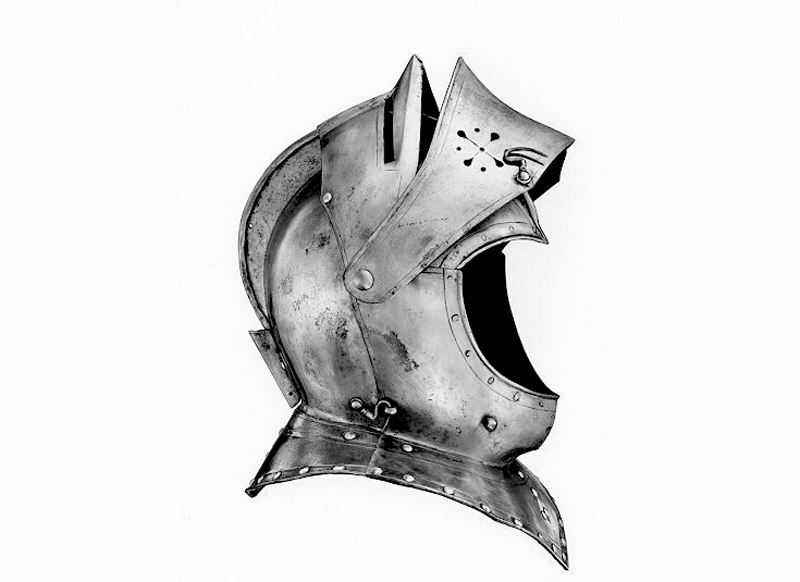http://ecx.images-amazon.com/images/I/51GDIBsJRNL._SL1001_.jpg
The only reason I'm asking is because in an old Hanwei-GDFB catalog, I see they used to sell a nearly identical looking helmet labeled "Closed European 17th Century".
The neck part looks loosely 17th century to me, but I'm not to familiar with this era of helmets.
Maybe it's a variation of this style?
http://www.bunrattycollection.com/img/resized...9_0438.jpg
Jojo,
Some 17th C close helmets were clumsily made, but none of them looked like that, though the pattern of the breathes can be seen on helmets like this close burgonet:
[ Linked Image ]
The other image you posted shows a 17th C cuirassier's armour displayed with the backplate where the breastplate should be. Note that the tassets should mount directly to the cuirass, and the garde des reins should cover the rump.
-Hildebrandt
Some 17th C close helmets were clumsily made, but none of them looked like that, though the pattern of the breathes can be seen on helmets like this close burgonet:
[ Linked Image ]
The other image you posted shows a 17th C cuirassier's armour displayed with the backplate where the breastplate should be. Note that the tassets should mount directly to the cuirass, and the garde des reins should cover the rump.
-Hildebrandt
Apart from being really badly made (at least from what we could see from the photo), it vaguely resembles this type: http://www.hermann-historica.de/auktion/hhm65...at65_a.txt - but thatīs end of 16th century. if you move to the 17th, much more typical were helmets like that already posted by Jeffrey, or like this one: http://www.hermann-historica.de/auktion/hhm65...at65_a.txt
as you can see, construction is different, with pronounced "sun visor" and no vision slits above it.
as you can see, construction is different, with pronounced "sun visor" and no vision slits above it.
Radovan is right in pointing out that the close burgonet supplanted the close helm in popularity in the 17th C, though close helms of a modified form continued to be made. The ocular slits became wider and the visor less protrusive, and breath patterns became more open and more likely to be symmetrical than before - all signs that the lance was less likely to be met with on the field.
The main difference to be noted between an actual 17th C close helm and the modern helmet Jojo posted is in the form and treatment of the visor assembly. As can be seen in this image of an open close helm, the ocular plate should tuck neatly behind the visor so as not to catch anything, while the modern version is flared out to sit on top of the visor. I have also included an image of a closed close helm, which belonged Charles I, King of England, and before that to his brother Henry. It was made in the Netherlands around 1613, and is entirely leaf-gilt.
There is some very interesting armour from this period which gets far too little attention.
-Hildebrandt
 Attachment: 157.49 KB
Attachment: 157.49 KB

 Attachment: 108.6 KB
Attachment: 108.6 KB

The main difference to be noted between an actual 17th C close helm and the modern helmet Jojo posted is in the form and treatment of the visor assembly. As can be seen in this image of an open close helm, the ocular plate should tuck neatly behind the visor so as not to catch anything, while the modern version is flared out to sit on top of the visor. I have also included an image of a closed close helm, which belonged Charles I, King of England, and before that to his brother Henry. It was made in the Netherlands around 1613, and is entirely leaf-gilt.
There is some very interesting armour from this period which gets far too little attention.
-Hildebrandt


Page 1 of 1
You cannot post new topics in this forumYou cannot reply to topics in this forum
You cannot edit your posts in this forum
You cannot delete your posts in this forum
You cannot vote in polls in this forum
You cannot attach files in this forum
You can download files in this forum
All contents © Copyright 2003-2006 myArmoury.com — All rights reserved
Discussion forums powered by phpBB © The phpBB Group
Switch to the Full-featured Version of the forum
Discussion forums powered by phpBB © The phpBB Group
Switch to the Full-featured Version of the forum